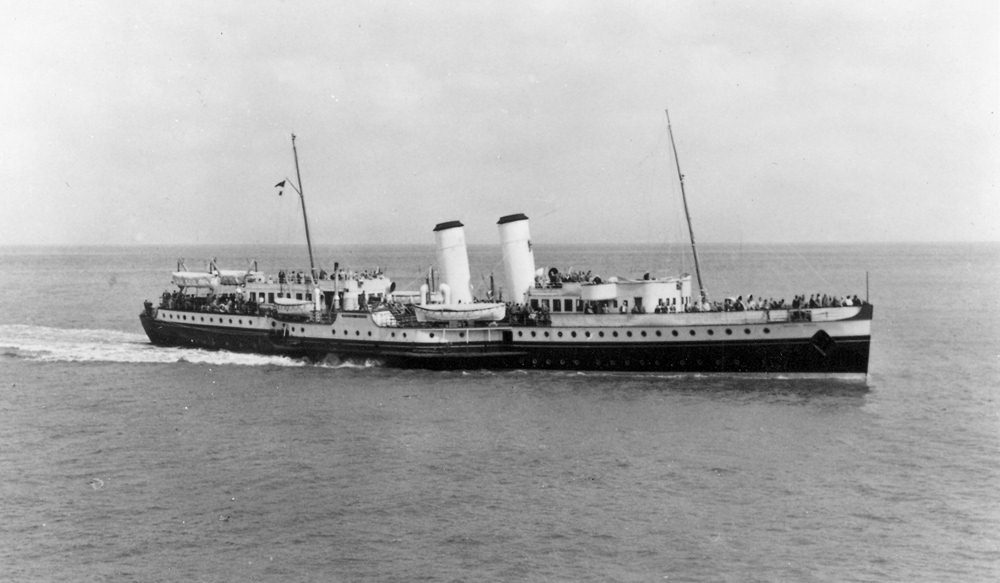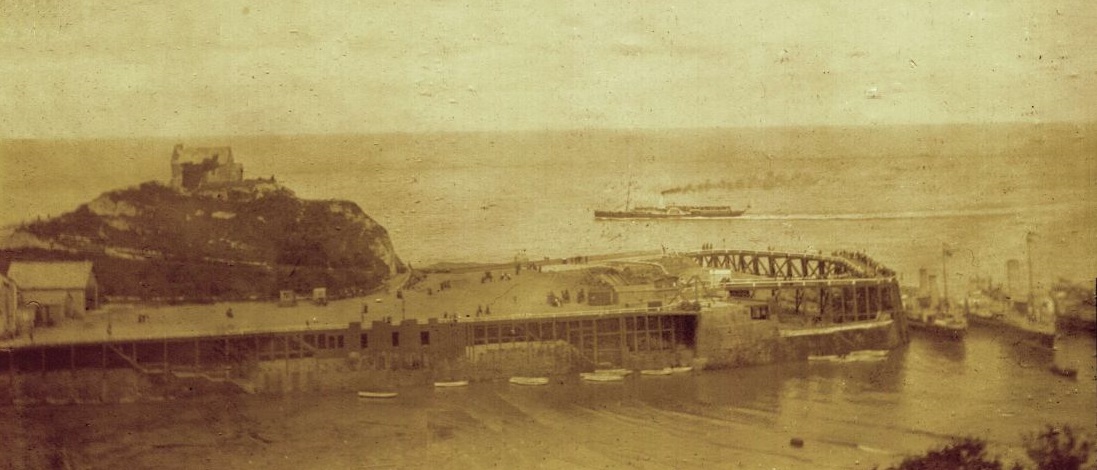paddlesteamers.info : The Internet's leading website for
Side-Wheeled Paddle Steamers
Historical
Database : Bristol Channel, United
Kingdom
The Bristol
Channel is the name given to the wide estuary of the River Severn in
the south west of the United Kingdom, with the coast of South Wales
forming the northern shore and the coasts of the English counties of
Somerset, Devon and Cornwall the southern. With a tidal variation of
40 feet, the channel has the second highest tidal variation on the
earth which, combined with strong currents and shifting sandbanks on
its upper reaches, makes navigation difficult.
Unlike the relatively sheltered Firth of Clyde, the Channel can be
extremely treacherous, especially on the more exposed waters where
the estuary meets the Atlantic Ocean and the Irish Sea. The crossing
from Swansea in Wales to Ilfracombe in Devon and the excursion to the
island of Lundy were particularly prone to poor weather. The tidal
variation also resulted in many piers being inaccessible at low tide
and steamer sailing schedules had to be constantly adjusted to take
tides into account.
The major city in the area, Bristol, was the centre of operations,
although considerably upstream on the River Avon. The main cruise
destination was Ilfracombe with services from Bristol and Cardiff
. A regular ferry
service operated from Cardiff to Weston-super-Mare which continued
until the end of the paddle-steamer era and the opening of the Severn
Bridge, and for many years, a service linked the down-stream ports of
Swansea and Ilfracombe.

Above
: Bristol Queen in an official P&A Campbell photo. Although not the
last paddle steamer built for the Bristol Channel (P&A Campbell's
Cardiff Queen followed shortly afterwards) it perhaps marks the zenith
of British paddle steamer construction. Unlike Cardiff Queen of
1947 which came from the Fairfield shipyard on the Clyde and whose
design was closely based on paddle steamers supplied to a Clyde
operator shortly before World War II, Bristol Queen was built locally
in Bristol by Charles Hill. Campbells had always returned to their
Clyde roots for their paddle steamers and although using Fairfield was
a new departure for them, using Hill was a remarkable departure from
tradition. The yard had no track record of building paddle steamers and
used design principles more associated with coastal screw steamers.
However, the result was a highly-regarded steamer and one probably more
suited to the rigours of the highly tidal and exposed waters of the
Bristol Channel than Cardiff Queen.
Image by kind courtesy of Nigel Lawrence
.
STEAMER
OPERATIONS
The
Bristol Channel was to develop into one of the major areas for Paddle
Steamer operation in the UK after the decision of Peter and Alec
Campbell, sons of the well-known Firth of Clyde steamboat owner
Captain Bob Campbell, to sell their business to the newly-formed
Caledonian Steam Packet Company and, from 1889, base their operations
at Bristol. The inevitable domination of the Clyde services by three
competing railway companies and the under-development of steamer
operations on the Bristol Channel made the move a sensible decision.
In 1887, Campbell's paddler Waverley had been chartered for use on
the channel and in the following year, Captain Alec brought the
vessel south once again on his own account. Captain Bob died in April
1888 but the scene was set for P & A Campbell's "White Funnel"
fleet to dominate coastal cruising and ferry operations for the next
80 years.
Paddlers had been present on packet services on the Channel since the
early days of steam navigation, but the Campbell brothers were quick
to spot the gap in the market and their arrival marked the begining
of the heyday of the excursion steamer era. Several private
interests, most importantly Edwards and Robertson, attempted to gain
a share of the lucrative cruise trade, but were unable to compete
financially. The Barry Railway Company was, however, a different
proposition. With new tonnage introduced in 1905, the Campbells
resorted to legal means to restrict the railway company's scope of
operations and the success of these actions effectively led to the
Barry company selling their steamers in 1910, The company which took
over the vessels was unable to compete effectively and sold out to
Campbells in December 1911.
PS Ravenswood was the first of a long line of new steamers built for
the Campbell's Bristol Channel service, taking up her station in
1891 alongside Waverley. The paddle steamer era appeared to have
ended when the last two members of Campbell's fleet, Cardiff Queen
and Bristol Queen were withdrawn in 1966 and 1967 respectively and
Campbell's continued a service with a variety of second-hand motor
vessels until early 1981 when it was announced that operations would
finally cease.
In an interesting twist of fate, the Paddle Steamer Waverley, launched in 1946 and retired from
service on Ilfracombe
benefited enrmously from the development of the excursion steamer
business and it was not uncommon for several paddlers to be berthed
abreast of each other. The inner face of the pier was only accessible
at or near high tide, hence the need to tie up this way. In this view
from the mid 1890s believed to be by Alexander Hutson and kindly
supplied by Jeremy Hutson at least three paddlers await their
passengers for a return up-channel or over to South Wales, while
passing by in a westwards direction is P&A Campbell's paddler
Waverley - the ship which in effect started off the excursion cruise
industry in a meaningful way. the Clyde, was brought back into operation on behalf of
preservationist owners in 1975 and made a surprise appearance on the
Channel in 1979 as her enterprising owners had decided that she had
to operate outside the main Clyde season in order to help cover
costs. The success of the venture has led to Waverley visiting the
Bristol Channel for a month before the main summer season and for a
week in late Autumn each year since. Waverley's owners also spotted
the revenue potential of continuing main season sailings on the
channel, purchasing the former Solent motor ferry Shanklin (renamed
Prince Ivanhoe) for the 1981 season. Her untimely loss after beaching
off the South Wales coast on August 3rd of 1981 almost ended the
venture, but the former Campbell vessel MV Balmoral was purchased in
1984 as a replacement and has become a great
success. So, the success of one Waverley, almost a century after an earlier
vessel of the same name, led to the revival of passenger services using a vessel
owned by the original Campbell company who had pioneered this type of business
at the end of the 19th century.
OPERATORS AND
FLEETS
Main incumbent operator
P &
A Campbell
Railway company challenger and private successor eventually bought out by P&A Campbell
Barry Railway Company / Barry and
Bristol Channel Steamship Company
Bristol Channel
Passenger Boats Ltd
Selected private owners
Edwards and Robertson
John Gunn
Martin and Marquand
WH Tucker and Co
James
Jones - the Swansea & Ilfracombe Steamship (Alexandra) Ltd
Captains Walter, James and William Pockett / Bristol Channel Steam
Packet Co / Pocketts's Bristol Channel Steam Packet Co
John Richards / Normandy Steamship Co
Bristol & Ilfracombe Pleasure
Steamers Ltd
Swansea & Ilfracombe Steamship Alexandra Ltd
Sir William Lewis

Ilfracombe
benefited enrmously from the development of the excursion steamer
business and it was not uncommon for several paddlers to be berthed
abreast of each other. The inner face of the pier was only accessible
at or near high tide, hence the need to tie up this way. In this view
from the mid 1890s believed to be by Alexander Hutson and kindly
supplied by Jeremy Hutson at least three paddlers await their
passengers for a return up-channel or over to South Wales, while
passing by in a westwards direction is P&A Campbell's paddler
Waverley - the ship which in effect started off the excursion cruise
industry in a meaningful way.
BIBLIOGRAPHY
Passenger
Steamers of the Bristol Channel - A Pictorial Record
Nigel Coombes
Published in 1990 by Twelveheads Press, Chy Mengketh, Twelveheads,
Truro, Cornwall, TR5 8SN
ISBN 0-906294-23-1
Extended captions to a wealth of photos, described in former PSPS
Chairman Nigel Coombes highly readable and authoratative style.
White Funnel Magic
Nigel Coombes
Published in 1995 by Twelveheads Press, Chy Mengketh, Twelveheads,
Truro, Cornwall, TR5 8SN
ISBN 0-906294-34-7
Nigel Coombes' follow-up volume looks at more aspects of the P&A
Campbell operation in a beautifully illustrated
book
White Funnels - The Story of
Campbell's Steamers 1946-68
Chris Collard
Published in 1996 by Baron Birch for Quotes
Ltd
ISBN 0-86023-570-X
The first volume of Chris Collard's study of the Cambell steamers
operational history drawing on extensive personal knowledge and
company
records
White Funnel Memories
George Gunn
Published in
1997 by Gomer Press, Lllanysul, Ceredigion, Wales
ISBN 1-85902-487-4
Authoritative
Campbell's story centring on the personalities involved - by the late George
Gunn, one of the Campbell fleet's finest captains
Return
to
Historical Database

